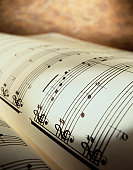
Home > Music Theory > Dotted Notes
|
|||||
How to Play Dotted Notes
Therefore, when a dot is placed after a half note, it adds a half a count making its value 3 beats. If the note is positioned in a space, the dot will be located in the same space. However, if the note is located on a line, the dot will be placed on the space above. This is to ensure that the dot is clearly visible at all times. Let’s begin with a whole note. If a dot is found immediately after a whole note, you must add half of its value. Therefore, if the count is set for 4/4, you will add 4 beats plus 2 beats. This results in the whole note being played for 6 beats. A dotted half note becomes 3 beats and a dotted quarter note becomes 1 ½ beats. Dotted whole notes and half notes are easy enough to understand, but you are most likely questioning how to hold a note for 1 ½ counts. A half beat is also called an eight note. Therefore, rather than counting by 4’s you will want to count by 8’s. This process makes playing syncopated rhythms easier. Double and triple dotted notes can also be found. When double dots are inserted, you augment the original note value by 75%. The first dot augments the note value by 50%, while the second note augments the previous dot by 50%, resulting in an increase of 75%. Triple notes have the same effect, however they are extremely rare. Example of triple notes can be found in Chopin’s Prelude Opus 28, No. 3. It is very important to not confused dotted notes with staccato articulation dots, which are located on top of and below the note. A dot can be added to virtually any note, making it a very versatile tool. The recognition of dotted notes can be found as far back as the 10th century. They were originally used across barlines, however pianists consider this method dated and utilize the tie across the barline. Discovering the process of how to play dotted notes can be an exciting and interesting adventure. In order to ensure that you have grasped the concept correctly, flip through your sheets or music and find a piece with multiple uses of dotted notes. Settle yourself down in front of the piano and practice their uses until you feel comfortable. Subsequent practices in order to fully understand and appreciate dotted notes may be necessary. Do not feel defeated. Dotted notes can be a pain to understand, therefore practice and patience will be necessary. Styles such as Irish Jigs, the 50’s Pop Ballads, and Shuffle Blues are based on three different divisions of a beat. This is where the dotted note becomes the most useful. Using dotted notes will save ink and time.
| |||||
|
Although every attempt has been made to make information as accurate as possible, we are not responsible for any errors that may appear.
 You will discover dotted lines during your acquisition of
You will discover dotted lines during your acquisition of 


